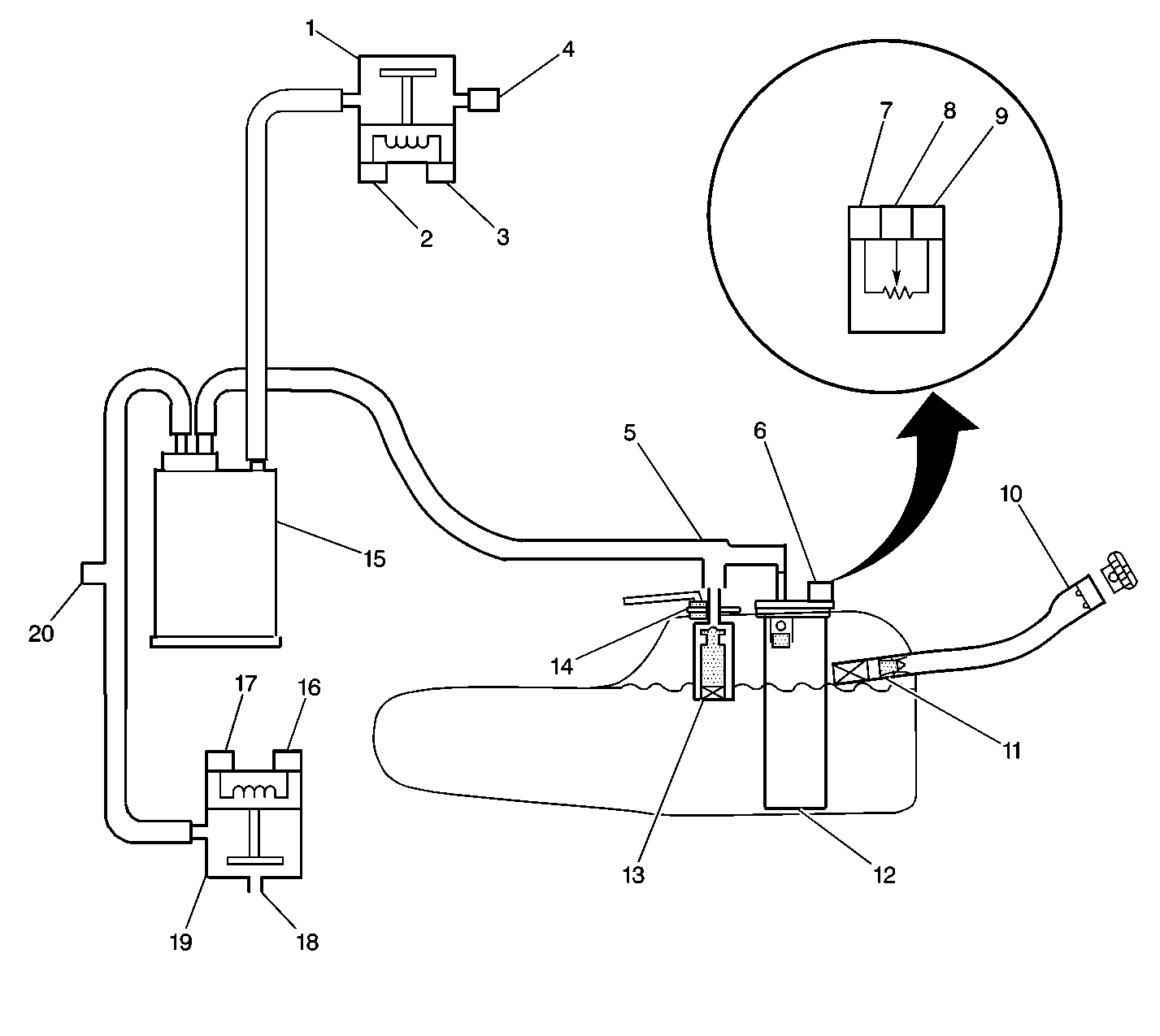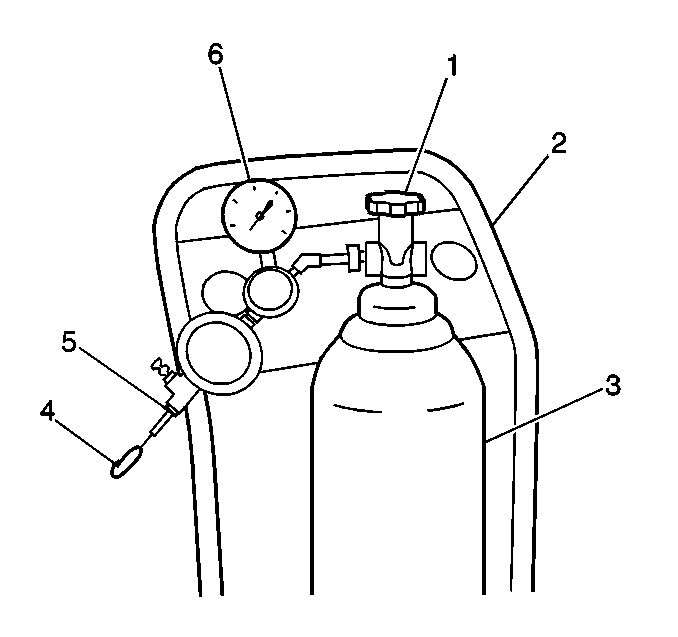Refer to
EVAP Control System Overview

EVAP System Description
The evaporative system includes the following components:
| • | The fuel tank. |
| • | The EVAP canister vent valve/solenoid. |
| • | The fuel tank pressure sensor. |
| • | The fuel pipes and hoses. |
| • | The fuel fill cap. |
| • | The EVAP vapor lines. |
| • | The EVAP purge lines. |
| • | The EVAP canister. |
| • | The EVAP canister purge valve/solenoid. |
THE POWERTRAIN CONTROL MODULE (PCM) supplies a ground to energize the EVAP purge valve (purge on). The EVAP purge valve control is Pulse Width Modulated (PWM) or turned on and off several times a second. The duty cycle (pulse width) is determined by engine operating conditions including load, throttle position, coolant temperature and ambient temperature. The duty cycle is calculated by the PCM and the output is commanded when the appropriate conditions have been met. The system checks for conditions that cause the EVAP system to purge continuously by commanding the EVAP vent valve ON (Closed) and the EVAP purge valve OFF (Closed). If vacuum level in the fuel tank increases during the test, a continuous purge flow condition is indicated. This can be caused by any of the following conditions:
| • | EVAP purge valve leaking internally. |
| • | EVAP purge and engine vacuum lines switched at the EVAP purge valve. |
| • | EVAP purge valve control circuit grounded. |
If any of these conditions are present, DTC P1441 will set.
Conditions for Running the DTC
| • | No ECT, IAT, MAP, TP, MAF sensor, VSS, HO2S, Misfire, Fuel Trim, Injector circuit, EGR Pintle Position DTCs set. |
| • | All conditions for DTC P0440, P0442 and P0446 diagnostic tests have been met and passed. |
| • | Startup engine coolant temperature is not more than 4°C and 30°C (40°F 86°F). |
| • | Startup engine is not more than 8° C (14° F). |
| • | Startup Intake air temperature not more than 2°C and 30°C (40°F and 86°F). |
| • | Startup intake air temperature not more than 2°C (4°F). |
| • | Fuel tank level is between 15% and 85%. |
| • | BARO is greater than 75kPa. |
Conditions for Setting the DTC
A continuous open purge flow condition is detected during the diagnostic test (fuel tank pressure decreases to less than -11 in. H2O.
Action Taken When the DTC Sets
| • | The PCM will illuminate the MIL during the first trip in which the diagnostic test has been run and failed. |
| • | The PCM will store conditions which were present when the DTC set as Freeze Frame and Fail Records data. |
Important: Although these diagnostics are considered type A, they act like type B diagnostics under certain conditions. Whenever the EVAP diagnostics report that the system has passed, or if the battery has been disconnected, the diagnostic must fail during two consecutive cold start trips before setting a DTC. The initial failure is not reported to the diagnostic executive or displayed on a scan tool. A passing system always reports to the diagnostic executive immediately.
Conditions for Clearing the MIL/DTC
| • | The PCM will turn the MIL OFF during the third consecutive trip in which the diagnostic has been run and passed. |
| • | The history DTC will clear after 40 consecutive warm-up cycles have occurred without a malfunction. |
| • | The DTC can be cleared by using the scan tool Clear Info function or by disconnecting the PCM battery feed. |
Diagnostic Aids
Check for the following conditions:
| • | Poor connection at the PCM. |
| Inspect harness connectors for backed out terminals, improper mating, broken locks, improperly formed or damaged terminals, and poor terminal to wire connection. |
| • | Damaged harness. |
| Inspect the wiring harness for damage. |
| • | If the harness appears to be OK, connect the J 41413 EVAP purge/pressure diagnostic station to the EVAP service port, pressurize the EVAP system to 10 in. H2O and observe the Fuel Tank Pressure display on the scan tool while moving connectors and wiring harnesses related to the EVAP purge valve. A sudden change in the display will indicate the location of the malfunction. |
| • | Incorrect vacuum line routing. |
| Verify that the source vacuum line routing to the EVAP purge valve is correct and that the EVAP purge and source vacuum lines to the EVAP purge valve are not switched. |
| • | Malfunctioning or damaged canister. |
| Use the following procedure to check for a carbon release condition: |
| 1. | Turn OFF the ignition switch. |
| 2. | Remove the EVAP purge valve. Refer to EVAP Canister Purge Valve Replacement . |
| 3. | Lightly tap the EVAP purge valve on a clean work area looking for carbon particles exiting either of the vacuum ports. |
| 4. | If no carbon release is evident, reinstall the components and continue with the DTC P1441 table. If carbon is being released from either component, continue with this service procedure. |
| 5. | Remove the charcoal canister from the vehicle. |
| 6. | Ensure that the main cylinder valve is turned off on the

|
| 7. | Disconnect the black hose that connects the nitrogen cylinder to the EVAP purge/pressure diagnostic station at the pressure regulator by unscrewing the knurled nut on the regulator. No tools are required to remove the black hose from the regulator. |
| 8. | Using a section of vacuum line, connect one end over the open threaded fitting of the EVAP purge/pressure diagnostic station pressure regulator. |
| 9. | Connect the remaining end to the EVAP purge valve end of the EVAP purge line at the vehicle and turn on the main nitrogen cylinder valve. Continue to blow any debris from the purge line for 15 seconds. |
| 10. | Return the EVAP Pressure/Purge Diagnostic Station to its original condition by re-installing the black hose that was disconnected in step 7. |
| 11. | Replace the following components: |
| • | The EVAP purge valve. Refer to EVAP Canister Purge Valve Replacement . |
| • | The EVAP canister. Refer to EVAP Canister Replacement . |
| 12. | Proceed with the DTC P1441 diagnostic table. |
Reviewing the Fail Records vehicle mileage since the diagnostic test last failed may help determine how often the condition that caused the DTC to set occurs. This may assist in diagnosing the condition.
Test Description
Number(s) below refer to the step number(s) on the Diagnostic Table:
-
If an EVAP purge valve electrical malfunction is present, the purge system will not operate correctly. Repairing the electrical malfunction will very likely correct the condition that set this DTC.
-
Checks for a Fuel Tank Pressure sensor stuck high condition. The fuel tank pressure must be relieved by removing the canister line from the fuel tank or EVAP canister. The fuel fill cap will not relieve the tank due to a check valve in the filler neck. The check valve seals when pressure is applied to prevent vapors from escaping through the filler neck. The scan tool should read within +/- 1.0 in. H2O of the specified value.
-
Checks for a leaking or stuck open EVAP canister purge valve/solenoid. the scan tool should read within +/- 1.0 in. HG of the specified value.
-
Verifies that the fuel tank pressure sensor accurately reacts to EVAP system pressure changes. the EVAP station is pressurizing a sensor that normally reads vacuum. The Tech II reads high pressure at 0 volts and high vacuum at 5 volts. The Tech II can only read a max pressure of 6.0 in. of H2O (0 Volts). However the EVAP Service Station can pressurize the system to much higher pressures. The Scan Tool value should be within +/- 0.5 of the specified value.
-
If the EVAP purge and engine vacuum lines are switched at the EVAP Purge Valve/Solenoid, the valve/solenoid will leak vacuum.
-
The EVAP station is pressurizing a sensor that normally reads vacuum. The Tech II reads High pressure at 0 volts and high vacuum at 5 volts. The Tech II can only read a max pressure of 6.0 in. of H2O (0 Volts). However the EVAP Service Station can pressurize the system to much higher pressures. The Scan Tool value should be within +/- 0.5 of the specified value.
Step | Action | Value(s) | Yes | No | ||||
|---|---|---|---|---|---|---|---|---|
Was the Powertrain OBD System Check performed? | -- | |||||||
|
Important: Visually/Physically inspect for the following conditions:
Is DTC P0443 Evaporative Emission (EVAP) Purge Solenoid Control Circuit or DTC P0449 Evaporative Emission (EVAP) Vent Solenoid Control Circuit also set? | -- | Go to other DTC(s) first | ||||||
Is the Fuel Tank Pressure near the specified value? | 0 in. H2O | |||||||
|
Important: : Before continuing with diagnosis, zero the EVAP Pressure and Vacuum (inches of H2O) gauges on the J 41413 EVAP purge/pressure diagnostic station, refer to tool operating instructions. Important: Do not exceed the pressure in the specified value.
Can the specified value be achieved? | 5 in. H2O | |||||||
Is the Fuel Tank Pressure at the specified value? | 5 in. H2O | Go to Diagnostic Aids | ||||||
Are the EVAP purge and source vacuum lines connected correctly at the EVAP purge valve? | -- | |||||||
7 |
Is vacuum level near the specified value? | 0 in. Hg | Go to Diagnostic Aids | |||||
8 |
Important: : Check for carbon release into the EVAP system. Refer to Diagnostic Aids. Is the action complete? | -- | -- | |||||
9 |
Is the action complete? | -- | -- | |||||
10 |
Was a problem found? | -- | Go to DTC P0452 Fuel Tank Pressure Sensor Circuit Low Voltage | |||||
11 |
Is action complete? | 0 in. H2O | -- | |||||
12 |
Is the Fuel Tank Pressure near the specified value? | 0 in. H2O | Go to DTC P0453 Fuel Tank Pressure Sensor Circuit High Voltage | |||||
Does the EVAP pressure decrease to less than the second specified (lower) value within 2 minutes with the rotary switch in the "Off/Hold" position? | 15 in. H2O 10 in. H2O | System OK |
